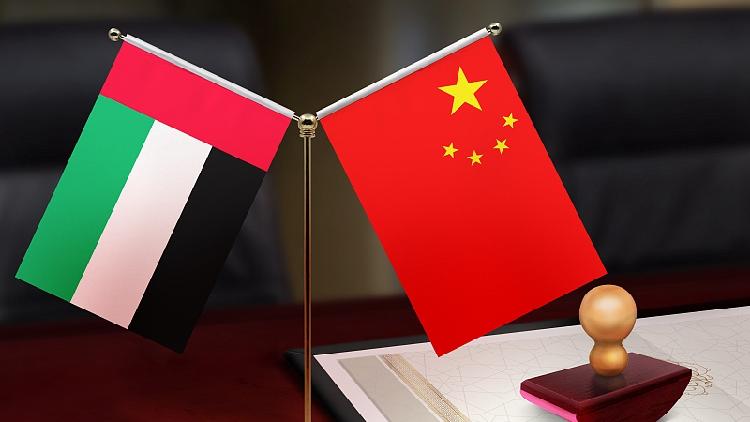China-UAE economic cooperation entering new era


Editor’s note: Liu Chang is an assistant researcher at the Institute of Russian of East European and Central Asian Studies at the Chinese Academy of Social Sciences. Liu Jiahao is a PhD candidate from the University of Chinese Academy of Social Sciences. The article reflects the authors’ opinions and not necessarily the views of CGTN.
Dubai International Airport is the first stop for most people who are getting to know the UAE. Anyone who comes here for the first time may be shocked by its huge area, big flow of people and most distinctively passengers and staff with different skin colors and speaking different languages. Of course, prices there are far from cheap.
The reason why this airport has become the world’s second-largest airport in terms of traffic is closely related to the UAE’s superior geographical location. The UAE is located at the southeastern tip of the Arabian Peninsula and is a key point of maritime transportation from the Persian Gulf to the Indian Ocean. It connects many countries and regions in Asia, Europe, Africa and is an important transportation hub in the Middle East.
In addition, the UAE also has abundant energy resources. As of 2022, the UAE’s oil production accounts for 4.3 percent of the world’s total, making it the world’s seventh largest oil supplier; its crude oil reserves and natural gas reserves are both among the top ten in the world.
The unique conditions have laid a solid foundation for the economic development of the UAE. Since its founding in 1971, the UAE has adopted a steady domestic and foreign policy, with a stable domestic political situation and a growing economy, becoming a beautiful landscape in the turbulent Middle East. The UAE is one of the most stable countries in the Middle East with the fastest economic development and the highest degree of integration into globalization.
However, similar to other Middle Eastern countries, the UAE economy is outward-oriented, overly dependent on oil, and vulnerable to international market fluctuations. In order to achieve sustainable economic development, the UAE is actively seeking diversified economic transformation.
In 2010, the UAE launched the UAE Vision 2021, placing sustainable development at the core of the UAE’s development in the next few decades; in 2012, the UAE proposed a green growth strategy; in 2015, the UAE approved and formally implemented the UAE Green Agenda 2015-2030; in 2017, the UAE issued the Energy Strategy 2050, planning to increase the proportion of clean energy in the energy structure from the current 25 percent to 50 percent in the next 30 years. Driven by a series of initiatives, the UAE has achieved a series of results in diversified transformation and is ahead of other economies in the Middle East.
On the one hand, this is related to the UAE government’s active opening-up policy, good business environment, low tax policy and so on. On the other hand, economic cooperation with China, especially after the Belt and Road Initiative was proposed, has played an important role.
As of 2022, China is the UAE’s main source of imports, with an import proportion of 18 percent, far ahead of other economies. The UAE has been China’s main investor in the Middle East since 2014, the largest export market and second-largest trading partner for many years, attracting more than 6,000 Chinese companies to settle down here.
In addition to the growing trade and investment volume, the cooperation structure between China and the UAE has been continuously optimized. From the perspective of trade, the UAE mainly imports mechanical and electrical products and nuclear reactors from China. China mainly imports crude oil and mineral fuel products from the UAE. Chinese companies’ investments are distributed in various fields in the UAE, such as steel, energy, building materials, hardware, construction machinery, chemicals and others.
In recent years, the UAE has increased its investment in the high-tech sector to accelerate economic transformation. In 2017, the UAE government issued the “Fourth Industrial Revolution Strategy,” hoping to increase the contribution of advanced manufacturing to economic development by promoting innovation and developing future technologies. In 2020, the UAE established the Ministry of Industry and Advanced Technology and released the national industrial strategy “300 Billion Action” in 2021.
Faced with the opportunities of a new round of scientific and technological revolution and industrial transformation, China-UAE cooperation is constantly improving and upgrading, and information technology, artificial intelligence, digital economy, new energy, medicine and other fields are becoming a new growth point.
This year marks the 40th anniversary of the establishment of diplomatic relations between China and the UAE. Under the strategic guidance of top leaders, China-UAE relations have maintained a good momentum of development, setting an example for relations between China and Arab countries in the new era. Standing at a new historical node, the consensus on development and highly complementary economic cooperation, will promote the vigorous development of China-UAE comprehensive strategic partnership and better benefit the people of the two countries.
(Cover via CFP)

